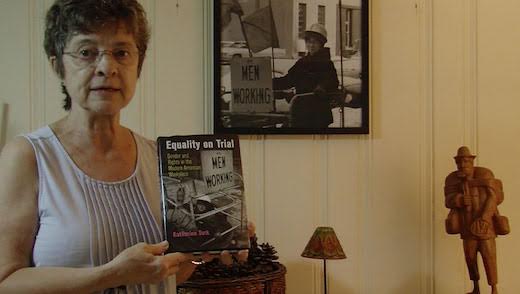
CHICAGO – I met Margaret Fulkerson as I was staffing an Illinois Labor History Society table at this year’s Labor Notes conference. She was promoting the campaign to create a Mother Jones museum in Mt. Olive, Ill. I had been to the Mt. Olive monument for Jones (who chose to be buried there, near those miners killed in the 1898 Virden Massacre) and was glad to contribute to the cause. I casually asked what union she was in and she told me Communications Workers of America, which is the same union I belong to. But what she told me next really blew me away.
Fulkerson said she was the first journeywoman cable splicer in the Midwest for AT&T and had just given a presentation to the Equal Employment Opportunity Commission about the consent decree that had led to her hiring. I felt that I needed to know her story. I told her I was in school but when classes ended in May, I would get in touch with her because I wanted to do a feature on this little known consent decree and her journey as a journeywoman for People’s World.
Some time after that serendipitous meeting, I signed up for an Introduction to Video course during Summer Session at Northeastern Illinois University. The first day of class the professor, Cindy Moran, an award-winning filmmaker, said we should start thinking about what we wanted to do for our final project. I thought of Margaret’s story immediately and a 3 minute 51 second video was born. (Story continues after video.)
Naturally, a brief video only touches on this subject. I have a lot more footage of Fulkerson and through my research learned more about affirmative action, quotas and the times from which these victories sprang. Starting with the Civil Rights Movement of the 1950s and 1960s through to the women’s movement into the 1970s, the victories in the legislative arena, namely the Civil Rights Act, and Title VII (which established the Equal Employment Opportunity Commission), helped create a governmental framework to tackle racial and gender discrimination at the workplace.
Today gender-based discrimination and the struggle against it look, sound and feel different than those faced by previous generations because progress has been made. Yet for many seemingly intransigent obstacles like the gender pay gap and job segregation, the tools to make progress have been dulled by the extreme Right, hurting democratic rights for all. Fulkerson’s story reminds us that there are still government policies designed to chip away at those obstacles instead of embedding them even deeper into the foundation of our nation.
Photo: Margaret Fulkerson stands next to a photo of her commissioned by the Illinois Labor History Society in the 1970s to document working people on the job. She is holding a new book by University of North Carolina Professor Katherine Turk, “Equality on Trial: Gender and Rights in the Modern American Workplace,” in which the AT&T consent decree is discussed. On the book cover is another photo of Fulkerson from the labor society series. | Teresa Albano/PW

MOST POPULAR TODAY

Zionist organizations leading campaign to stop ceasefire resolutions in D.C. area

High Court essentially bans demonstrations, freedom of assembly in Deep South

U.S. imperialism’s ‘ironclad’ support for Israel increases fascist danger at home


Communist Karol Cariola elected president of Chile’s legislature






Comments